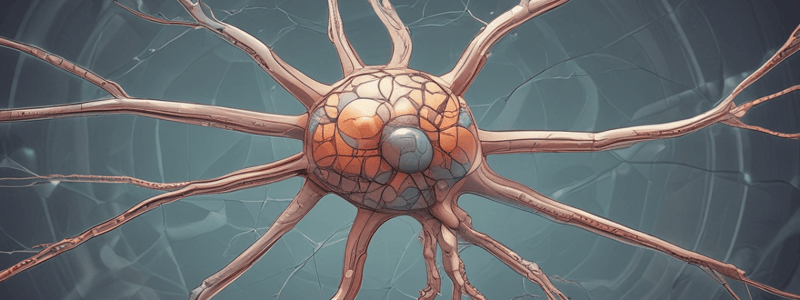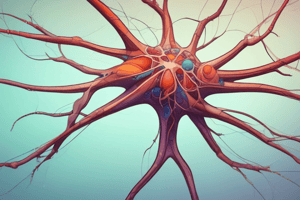Podcast
Questions and Answers
Which of the following is NOT a primary component of a neuron?
Which of the following is NOT a primary component of a neuron?
- Soma
- Axon
- Synapse (correct)
- Dendrite
Which of the following statements about neurons is TRUE?
Which of the following statements about neurons is TRUE?
- All neurons have the same number of dendrites.
- Some neurons can receive input from hundreds or even thousands of other neurons. (correct)
- Neurons communicate solely through electrical impulses.
- The length of an axon is always less than 1 inch.
Which of the following statements accurately describes the role of the soma (cell body) in a neuron?
Which of the following statements accurately describes the role of the soma (cell body) in a neuron?
- The soma is primarily responsible for generating the electrical signal that travels down the axon.
- The soma is responsible for releasing neurotransmitters at the synapse.
- The soma functions as the control center of the neuron, housing the nucleus and essential for cell maintenance. (correct)
- The soma is responsible for receiving input from other neurons.
What is the role of dendrites in a neuron?
What is the role of dendrites in a neuron?
What is the primary function of axons in a neuron?
What is the primary function of axons in a neuron?
Upon receiving a signal, what is the first action performed by dendrites?
Upon receiving a signal, what is the first action performed by dendrites?
What is the role of neurotransmitters in the nervous system?
What is the role of neurotransmitters in the nervous system?
What happens to the neuron immediately after an action potential has been generated?
What happens to the neuron immediately after an action potential has been generated?
What is the primary role of neurotransmitters in neuronal communication?
What is the primary role of neurotransmitters in neuronal communication?
What is the primary function of the cell body in a neuron?
What is the primary function of the cell body in a neuron?
What happens to the signal strength if it permits progression to the axon?
What happens to the signal strength if it permits progression to the axon?
What is the primary function of dendrites in a neuron?
What is the primary function of dendrites in a neuron?
How many primary components does a neuron have?
How many primary components does a neuron have?
Flashcards are hidden until you start studying
Study Notes
Neurons and the Nervous System
- Neurons are the fundamental building blocks of the nervous system.
- The nervous system consists of over 100 billion neurons, which serve as the body's primary control, regulatory, and communication system.
- Neurons are responsible for both receiving and transmitting critical information.
Structure of Neurons
- Three main components of neurons:
- Cell body (soma): Contains the nucleus and is vital for cell sustenance.
- Dendrites: Branch-like extensions that receive incoming information and send it to the soma.
- Axons: Long fibers that transmit signals away from the cell body to other neurons, muscles, or glands.
- Axons can extend considerable lengths, especially those connecting the spinal cord to peripheral muscles.
Communication Process
- Neurons use both electrical impulses and chemical signals for communication.
- An electrical impulse travels from dendrites to the soma and then to the axon.
- If the signal is strong enough, it reaches the axon, triggering an electrical event known as action potential.
Action Potential Mechanism
- Resting potential: The axon maintains a negative charge inside compared to the external environment.
- When stimulated above threshold, sodium ions enter, reversing the charge temporarily to positive (action potential).
- The action potential propagates rapidly along the axon, and can occur up to 1,000 times per second.
- Neurons operate on an all-or-nothing principle; they either fire completely or not at all.
Refractory Period
- Following an action potential, neurons cannot immediately fire again due to the refractory period, during which they return to their resting potential.
Synapses and Neurotransmitters
- Synapses are the gaps between neurons where signal transmission occurs; terminal buttons from one neuron nearly touch dendrites of another.
- Neurotransmitters are released into the synapse when an action potential reaches the terminal button.
- These chemicals fit into receptor sites on the receiving dendrites, facilitating signal transmission.
Effects of Neurotransmitters
- Neurotransmitters can exert excitatory or inhibitory effects on receiving neurons.
- Over 100 identified neurotransmitters manage various bodily functions, including appetite, memory, emotions, and muscle actions.
- Understanding neurotransmitter functions aids in comprehending behavior and emotional responses.
- Neurotransmitters' breakdown and reuptake occur after their action in the synapse, ensuring precise communication.
Implications of Neurotransmitters
- Certain neurotransmitters are linked to psychological and physical diseases.
- Awareness of neurotransmitter roles contributes to improved understanding of mental health and emotional well-being.
Neurons and the Nervous System
- Neurons are the fundamental building blocks of the nervous system.
- The nervous system consists of over 100 billion neurons, which serve as the body's primary control, regulatory, and communication system.
- Neurons are responsible for both receiving and transmitting critical information.
Structure of Neurons
- Three main components of neurons:
- Cell body (soma): Contains the nucleus and is vital for cell sustenance.
- Dendrites: Branch-like extensions that receive incoming information and send it to the soma.
- Axons: Long fibers that transmit signals away from the cell body to other neurons, muscles, or glands.
- Axons can extend considerable lengths, especially those connecting the spinal cord to peripheral muscles.
Communication Process
- Neurons use both electrical impulses and chemical signals for communication.
- An electrical impulse travels from dendrites to the soma and then to the axon.
- If the signal is strong enough, it reaches the axon, triggering an electrical event known as action potential.
Action Potential Mechanism
- Resting potential: The axon maintains a negative charge inside compared to the external environment.
- When stimulated above threshold, sodium ions enter, reversing the charge temporarily to positive (action potential).
- The action potential propagates rapidly along the axon, and can occur up to 1,000 times per second.
- Neurons operate on an all-or-nothing principle; they either fire completely or not at all.
Refractory Period
- Following an action potential, neurons cannot immediately fire again due to the refractory period, during which they return to their resting potential.
Synapses and Neurotransmitters
- Synapses are the gaps between neurons where signal transmission occurs; terminal buttons from one neuron nearly touch dendrites of another.
- Neurotransmitters are released into the synapse when an action potential reaches the terminal button.
- These chemicals fit into receptor sites on the receiving dendrites, facilitating signal transmission.
Effects of Neurotransmitters
- Neurotransmitters can exert excitatory or inhibitory effects on receiving neurons.
- Over 100 identified neurotransmitters manage various bodily functions, including appetite, memory, emotions, and muscle actions.
- Understanding neurotransmitter functions aids in comprehending behavior and emotional responses.
- Neurotransmitters' breakdown and reuptake occur after their action in the synapse, ensuring precise communication.
Implications of Neurotransmitters
- Certain neurotransmitters are linked to psychological and physical diseases.
- Awareness of neurotransmitter roles contributes to improved understanding of mental health and emotional well-being.
Neurons and the Nervous System
- Neurons are the foundational building blocks of the nervous system, comprising over 100 billion cells that gather, synthesize, and use environmental data.
- The nervous system functions as the primary control, regulatory, and communication system of the body, vital for processing information.
Structure of Neurons
- Neurons have three main components:
- Cell body (soma): Contains the nucleus and is essential for cell maintenance.
- Dendrites: Branching extensions that collect incoming information from other cells and route it to the soma.
- Axons: Long fibers that transmit information away from the soma to other neurons, muscles, or glands.
- Certain neurons possess extensive dendritic networks, allowing them to receive signals from numerous sources.
Myelin Sheath and Signal Transmission
- Axons are often covered by a myelin sheath, a fatty layer that accelerates signal transmission and prevents interference.
- Axonal terminals: At the end of axons, these branch out into terminal buttons that release neurotransmitters for communication across synapses.
Electrophysiology of Neurons
- Neurons communicate through an electrochemical process involving electrical impulses and chemical signals.
- When dendrites receive a signal, it generates an electrical impulse that travels down the axon if it exceeds a certain threshold.
- Action potential: This is the change in the axon's electrical charge, marked by a temporary influx of positively charged sodium ions that makes the inside of the axon more positive.
Nodes of Ranvier
- Interruptions in the myelin sheath create nodes of Ranvier that enhance the speed of impulse transmission by allowing the action potential to jump from one node to the next.
All-or-Nothing Principle
- Neurons operate on an all-or-nothing principle; the action potential either occurs fully or not at all. This mechanism allows neurons to increase firing rates rather than signal strength.
Refractory Period
- Following an action potential, a refractory period occurs where the axon cannot fire again until it returns to its resting potential, ensuring controlled signal transmission.
Neurotransmitter Functionality
- Neurotransmitters act as chemical messengers between neurons, facilitating information transmission across synapses, which are tiny gaps between neurons.
- They can produce excitatory or inhibitory effects on receiving neurons, influencing various bodily functions.
- After transmission, neurotransmitters are either broken down by enzymes or reabsorbed through reuptake mechanisms.
Impact of Neurotransmitters
- Over 100 types of neurotransmitters exist, significantly impacting appetite, memory, emotions, and muscle activity.
- Some neurotransmitters are linked to psychological and physical disorders, allowing for insights into behaviors and emotional responses.
Studying That Suits You
Use AI to generate personalized quizzes and flashcards to suit your learning preferences.




